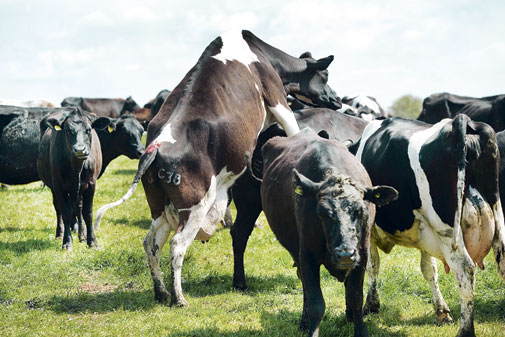Tail-painting – the low-tech way to block calving

High-tech computer systems to monitor oestrus have come to the fore in recent years, but going back to basics can prove just as effective. Aly Balsom finds out how
Identifying the fertility status of any cow often involves a trip to the farm office and a trawl through records, but what if you could get an idea of whole-herd fertility simply by looking over the field gate?
Somerset dairy producer Caroline Spencer has gone back to basics and turned to tail-painting her herd of 280 spring block-calving Jersey x Friesians and is reaping the benefits.
“The aim of our grass-based system is to keep it simple, maximise profits and have the best quality of life possible,” she says.
And although this has always been the aim at Volis Farm, Hestercombe, following a return to the family farm 10 years ago Mrs Spencer made a number of changes to improve profitability.
“Before, we ran a herd of 140 ‘autumn calving’ Holsteins producing 6500 litres, but we were never a ‘true’ block, with cows calving from September until May.” And although the farm had always used tail paint, the focus had not been on producing a condensed block.
“We decided to make the switch to spring block calving to make the most of grass and manage our tail-painting programme more closely.” Breeding was also changed and cow numbers increased.

And because Volis Farm is rented, this was an effective way of improving the system while avoiding major capital investment. The herd now produces 4900 litres at 5.12% fat and 3.78% protein for a local cheese processor.
“The beauty of block calving is the fact you can focus on one specific job at a time,” she says.
“You know when you are AI-ing you don’t need to calve cows and you can simply focus on mating.” And by keeping it simple, the farm can employ just one full-time manager and four part-time workers, including the family.
PRE-BREEDING TAIL PAINTING (starts 28 days prior to mating) |
|---|
Achieving a condensed breeding season is all part of creating a profitable system, Mrs Spencer explains. “A tighter calving block leads to easier management, better quality of life and more profits.”
And tail-painting has proved an effective tool at achieving this aim. “Oestrus detection does not have to be complicated – I can imagine computer-based heat detection systems are hugely costly, but using tail paints averages just 74p an animal a season.”
Four weeks prior to breeding, the herd undergoes pre-mating tail-painting to identify any non-cycling cows. In this way problem cows are identified early, giving the vet time to treat before mating begins.
“When the vet visits, a couple of days before the start of mating, all cows will be painted either green or red – the green indicating cows which have cycled and the red, those that haven’t.”
On routine vet visits throughout the practice, we are commonly presented with cows that are thought to be non-cycling, when in fact they have simply not been seen bulling, explains Kat Bazeley, Synergy Farm Health.
And tail-painting can prove a valuable tool in identifying cycling and non-cycling cows.
“Results from tail-painting at Volis Farm show a cheap, low-tech system can be an effective way of achieving good fertility results, provided it is used well,” Ms Bazeley says.
At the start of mating, all cows that have paint rubbed from the tail head as a result of mounting are drafted out at milking.
“All heats are identified in the parlour using a mirror on a stick so the milker can remain in the pit,” explains Mrs Spencer. Cycling cows are then AI’d to a Kiwi cross or New Zealand Friesian and tail-painted blue.
“As mating progresses you can gradually watch the herd turn blue. It is such a simple and visual way of monitoring fertility – just by walking through the field gate you can get a picture of whole herd fertility.
“You know the reds are the individuals you need to be worried about, any green cows are OK, but have not been served and the blues have been served.”
The herd is achieving at least 65% conception rates to first service with cows AI’d over a 4-6 week period, until semen runs out. Two teams of three Aberdeen Angus bulls are then put out on rotation.
“At the moment we are calving over a period of 12 weeks, but the aim in the next few years is to reduce this to nine weeks.”
The process of achieving this tighter calving window has already begun, with some late-calving cows sold on.
“So many cows are calving in February, we don’t need to keep the April calvers – by selling 15-20 tail-enders a year, fertility keeps getting better and better and they also provide us with a valuable income.”
All heifers are reared on farm with a herd replacement rate of 15%. “We only need 45 heifers a year, but we produce about 65-70 which we can then sell on as in-calf heifers.”
Heifers are served a week before the main herd so they calve in an earlier block. This year, Estrumate will also be used for the first time to ensure a block is achieved.
